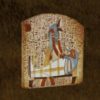Many of our modern ghost stories once served to illustrate things they believed about life. If you got ill, it was because an ancestor was upset or because they withdrew from your disrespect, and an evil non human spirit was permitted to enter you. The idea of the body as an object, but also as an abode for the spirit, is wide spread. There is a chapel, I believe located in Spain, composed entirely of the donated bones of the congregations deceased. Some view it as quite beautiful, but it was built taking the idea that the body was the temple of God quite literally.
Christians love the bones, as do Tibetans, and other cultures as well. A common belief in Native American, Norse, and Egyptian culture is that for the well being of the departed to be assured, the body must be kept intact. To date, our modern mortician practices still honor this idea, though not with any spiritual reason necessarily. So if a body was mutilated (scalping for example) the spirit would be consigned to a lesser existence, even lingering on the earth itself, thus the origin of the Chinese concept of the Jikiniki and such.
I hadn’t realized the scalping was such a big deal. Oh indeed, it was. It was a way of both seizing spiritual power and getting what they felt was a more real revenge, and it did vary.
Wasn’t it the Spanish who introduced the idea of scalping? The Spanish did practice it, but not for spiritual reasons. Evidence points that it originated from early Norse explorers contact, which leads us into the dishonored dead.
The evil dead, who were seen as evil while alive, were often denied proper burial rites in an effort to disconnect them from the afterlife of the beloved dead. So that is how the tradition of a hanging tree got started. First the tree was very carefully selected, because the trees were believed to have spirits also, and were specifically chosen near crossroads so that the obviously very angry spirit couldn’t find its way back to the community. And in the Celtic cases, they would be taken out by the wild hunt. It was clever thinking to get him lost and keep him trapped. A common hanging tree was a willow. It was believed they hate humanity anyway and would keep the spirit to torment it. The spirit associated with death, the raven, the owl, snakes, either dwelled in trees or they were observed to feed on the dishonored dead. In the case of the crow cage, it was often while the person was still alive but was considered fey or already dead.
Humans inventing ways to torment you even after death? Oh yes, and this raises the art of necromancy. In its most basic form it is merely communication with the land of the dead. But they believed that just as the forces that be affect us while alive, there were parallel forces in the land of the dead. So you would invoke fire symbolically, and this is part of how the association of fire with the souls of the damned got started. Originally, the hateful dead were not considered to be punished. The fire was a way to threaten them and keep them from mischief, but in some of the more warlike cultures including the Aztec, fire was the property of the Gods. So, even the God who is angry would burn the damned spirit with fire for one reason or another.
I’m afraid to ask, what is a crow cage? They imprison someone in an iron cage. It’s just a cage, sort of open but sealed shut with the person in it. And hang that with the person still alive at a crossroads. I will leave the rest up to you, but it is called a crow cage for a reason. They would have no way to kill themselves. No weapons, no other option to speed things. This is why many magical rituals were performed at crossroads. In the dark arts it was believed that those who died there in Greek myth became the children of the Titan and goddess Hecate.
They were really, really angry? Yes, so when contacted in ritual they would be eager to help with acts of revenge.
Your thoughts are welcome. Be well friends.
Travis Saunders
Dragon Intuitive
~science,mysticism,spirituality~



Leave a Reply